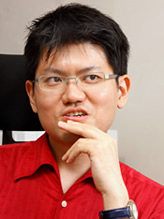2010/09/03
Solving the mystery of the brain through mathematical models (information science)
Lecturer Haruo Hosoya
(Department of Computer Science)

Lecturer Hosoya is the only neuroscience researcher in the Department of Computer Science.¬† ‚ÄúDeveloping real artificial intelligence‚ÄĚ is his goal and achieving it requires understanding information processing mechanisms in the human brain.¬† He is especially approaching emergence of intelligence through ‚ÄúComputational neuroscience.‚ÄĚ By taking advantage of mathematical models, the processes of intelligence genesis may be identified faster than many neuroscientists may expect.
Using methods in experiment-based neuroanatomy and physiology, neuroscience has learned about neuronal mechanisms and which part of the brain plays what function.¬† Enormous knowledge and findings have been gained through that, but it is partial and the whole brain mechanism is still to be explained.¬† Lecturer Hosoya notes that we will fully understand the brain only if we can ‚Äúmathematically model‚ÄĚ and ‚Äúreproduce‚ÄĚ functions created by combined neurons using a computer.¬† He uses ‚ÄúBayesian networks‚ÄĚ which is one of the methods in machine learning theory, a branch of information science, to predict information processing mechanisms of the brain with mathematical models.¬† Surprisingly, it is known to have a strong match with actual neuronal connections in the brain.
Bayesian networks only provide a universal framework.  So, the research aims at studying functions of neuronal aggregation responsible for particular tasks such as vision and motion by forming specialized networks and reproducing them on a computer.  At this moment, it is in the phase of successfully reproducing early visual system using the same mechanism as the brain. If everything goes according to the scenario, basic mechanisms may be explained in the next decade or so.
‚ÄúNeuroscience pursues the essence of human beings and, at the same time, has unlimited potential for broad application.¬† That is why it is so interesting,‚ÄĚ says Lecturer Hosoya who positions neuroscience as an academic discipline through which information scientists can make extremely important contributions.

